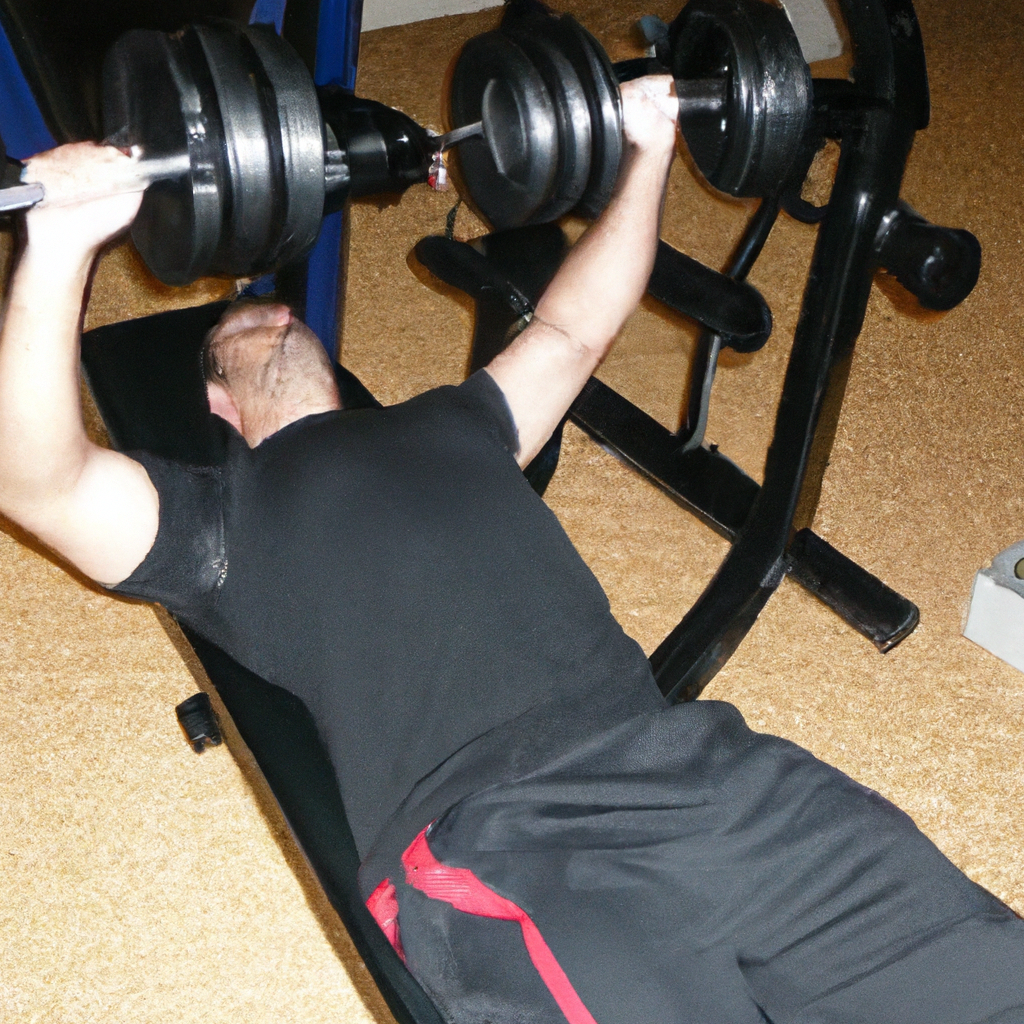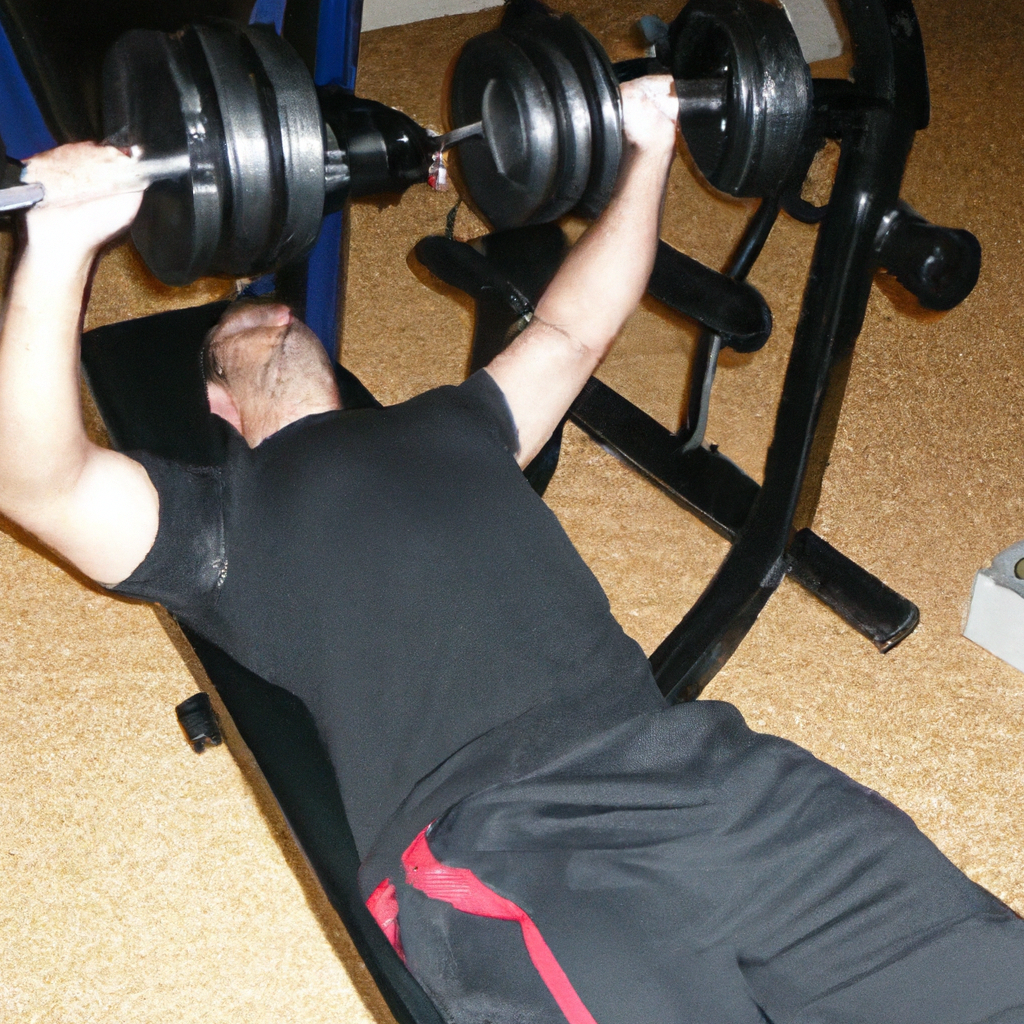Imagine yourself at the gym, ready to take your workout to the next level. One exercise that is sure to enhance your upper body strength and target your chest muscles is the Decline Dumbbell Press. By lying on a decline bench and utilizing dumbbells, this exercise specifically targets your lower chest, shoulders, and triceps. Whether you’re a seasoned gym-goer or a beginner looking to add a new move to your routine, the Decline Dumbbell Press is a fantastic addition to any workout. Get ready to feel the burn and see results with this challenging yet rewarding exercise.
Benefits of Decline Dumbbell Press
Increased chest activation
The decline dumbbell press is an excellent exercise for targeting the chest muscles. By performing the exercise on a decline bench, you increase the activation of the chest muscles compared to a regular flat bench press. This increased activation leads to greater strength gains and muscle development in the chest area.
Recruitment of lower chest muscles
One of the primary benefits of decline dumbbell press is that it specifically targets the lower chest muscles. This exercise helps to shape and develop the lower pecs, giving them a fuller and more defined appearance. By incorporating decline dumbbell press into your routine, you can achieve a well-rounded and proportionate chest.
Improved shoulder stability
Another advantage of decline dumbbell press is the enhancement of shoulder stability. When performing the exercise on a decline bench, you engage the stabilizing muscles of the shoulder and upper back to a greater extent. This increased stability not only reduces the risk of injury but also allows you to lift heavier weights and build more upper body strength.
Enhanced range of motion
Compared to a flat bench press, the decline dumbbell press offers a greater range of motion. This increased range of motion allows for a deeper stretch of the chest muscles, leading to improved muscle fiber recruitment and greater overall muscle development. By incorporating decline dumbbell press into your routine, you can target the chest muscles more effectively and achieve better results.
Better development of upper body strength
The decline dumbbell press is a compound exercise that targets not only the chest muscles but also other upper body muscles such as the anterior deltoids and triceps brachii. By performing this exercise regularly, you can develop overall upper body strength, improve muscle symmetry, and enhance your physical performance in other exercises and activities.
Correct Technique for Decline Dumbbell Press
Setting up the decline bench
Before starting the decline dumbbell press, it is crucial to set up the decline bench properly. Ensure that the bench is adjusted to a suitable decline angle, typically around 30 to 45 degrees. This angle allows for optimal activation of the chest muscles while still maintaining stability and control during the exercise.
Selection of appropriate dumbbells
Choose dumbbells that are suitable for your strength and fitness level. Start with lighter weights if you are a beginner and gradually increase the weight as you become stronger and more comfortable with the exercise. Using excessively heavy dumbbells can compromise your form and increase the risk of injury.
Positioning the dumbbells correctly
Sit on the decline bench, holding the dumbbells with a neutral grip (palms facing inwards). Position the dumbbells just above your shoulders, with your elbows flexed at a 90-degree angle. This starting position ensures that the chest muscles are engaged right from the beginning of the exercise.
Maintaining proper form
To perform the decline dumbbell press with proper form, lower the dumbbells towards the sides of your chest, keeping your elbows at a 45-degree angle to your body. Engage your chest muscles to push the dumbbells back up to the starting position, extending your arms fully at the top of the movement. Maintain a controlled and smooth motion throughout the exercise, avoiding any jerking or swinging of the dumbbells.
Breathing technique during the exercise
Proper breathing technique is essential during the decline dumbbell press. Inhale as you lower the dumbbells towards your chest, and exhale as you push the dumbbells back up to the starting position. Avoid breath-holding or shallow breathing, and maintain a steady and controlled breathing rhythm throughout the exercise. Proper breathing not only helps to stabilize your core but also ensures sufficient oxygen supply to your muscles.

Common Mistakes to Avoid
Using excessive weight
One of the most common mistakes people make when performing the decline dumbbell press is using weights that are too heavy. This not only compromises your form but also increases the risk of injury. Always start with a weight that is challenging but allows you to maintain proper form and complete the desired number of repetitions with control.
Flaring elbows out too much
Another common mistake is flaring the elbows out excessively during the exercise. This places unnecessary strain on the shoulder joints and shifts the focus away from the chest muscles. Keep your elbows at a 45-degree angle to your body throughout the movement to ensure maximum activation of the chest muscles.
Not lowering the dumbbells enough
Many individuals tend to perform the decline dumbbell press with a limited range of motion, not lowering the dumbbells towards the chest fully. By neglecting the full range of motion, you miss out on the opportunity to fully engage the chest muscles and achieve optimal muscle development. Aim to lower the dumbbells until they lightly touch your chest before pushing them back up.
Neglecting proper scapular retraction
Scapular retraction refers to squeezing your shoulder blades together during the exercise. Neglecting to do this can lead to poor posture and improper activation of the chest muscles. Focus on retracting your shoulder blades and maintaining a stable and supported upper back throughout the entire movement.
Lack of control during the exercise
Maintaining control throughout the exercise is crucial for maximizing muscle activation and reducing the risk of injury. Avoid using momentum or swinging the weights to complete the repetitions. Keep the movement smooth and controlled, with a deliberate focus on engaging the chest muscles throughout the exercise.
Muscles Targeted by Decline Dumbbell Press
Pectoralis major
The primary muscle targeted by the decline dumbbell press is the pectoralis major, or the chest muscle. This exercise specifically emphasizes the lower portion of the chest, helping to develop a well-defined and sculpted chest.
Anterior deltoids
The anterior deltoids, located at the front of the shoulders, are also heavily engaged during the decline dumbbell press. By targeting the chest muscles, this exercise indirectly works the anterior deltoids, leading to improved shoulder aesthetics and overall upper body strength.
Triceps brachii
The triceps brachii, the muscles located at the back of the upper arm, play a significant role in stabilizing and extending the elbow joint during the decline dumbbell press. This exercise provides an effective means of strengthening and sculpting the triceps, leading to improved arm strength and definition.
Serratus anterior
The serratus anterior, a group of muscles located on the sides of the ribcage, is also activated during the decline dumbbell press. These muscles help to stabilize and protract the scapulae, allowing for proper form and execution of the exercise.
Rectus abdominis
Although not a primary target of the decline dumbbell press, the rectus abdominis, or the abdominal muscles, are engaged to stabilize the core during the exercise. This additional engagement of the core muscles helps to improve overall core strength and stability.

Alternative Exercises for Decline Dumbbell Press
Flat dumbbell press
The flat dumbbell press is an excellent alternative to the decline dumbbell press, particularly for individuals who may have limitations or discomfort performing the exercise on a decline bench. This exercise targets the entire chest muscles and provides a foundation for building upper body strength.
Incline dumbbell press
The incline dumbbell press is another alternative that focuses on targeting the upper chest muscles. By adjusting the bench to an incline position, you shift the emphasis to the upper portion of the chest, creating a more well-rounded chest development.
Push-ups
Push-ups are a versatile and effective bodyweight exercise that targets the chest muscles, along with other upper body muscles. They can be modified to suit different fitness levels and provide a great alternative to dumbbell exercises.
Cable chest press
The cable chest press is performed using a cable machine and allows for a smooth and controlled range of motion. This exercise provides consistent tension throughout the movement, leading to increased muscle activation and strength gains.
Decline barbell press
Similar to the decline dumbbell press, the decline barbell press targets the lower chest muscles. By using a barbell instead of dumbbells, you can typically lift heavier weights and challenge your muscles further.
Safety Tips for Decline Dumbbell Press
Start with lighter weights
As with any exercise, it is important to start with lighter weights to ensure proper form and reduce the risk of injury. Begin with a weight that allows you to complete the desired number of repetitions with control.
Use a spotter if necessary
If you are unsure of your strength level or feel that you may need assistance during the exercise, it is always advisable to have a spotter. A spotter can help provide guidance, support, and assistance in case you are unable to complete a repetition.
Listen to your body’s limitations
Pay attention to any discomfort or pain during the decline dumbbell press. If you experience any unusual pain or discomfort, stop the exercise and consult a medical professional. It is important to listen to your body and not push through pain or discomfort.
Avoid excessive shoulder rotation
During the decline dumbbell press, it is important to maintain proper shoulder alignment and avoid excessive rotation. Excessive rotation can put undue strain on the shoulder joints and increase the risk of injury. Focus on keeping your shoulders stable and supported throughout the exercise.
Maintain a controlled and smooth motion
To ensure safety and optimal muscle activation, maintain a controlled and smooth motion during the decline dumbbell press. Avoid any jerking or sudden movements that can increase the risk of muscle strains or joint injuries. Focus on maintaining proper form and engaging the targeted muscles throughout the exercise.

Incorporating Decline Dumbbell Press into your Workout Routine
Warming up properly
Before performing the decline dumbbell press or any other exercise, it is essential to warm up the muscles and prepare them for the workout. Start with dynamic stretches and light cardio exercises to increase blood flow and warm up the entire body.
Selecting an appropriate weight
Choose a weight that challenges your muscles but still allows you to maintain proper form. The weight should be heavy enough to fatigue the muscles within the desired rep range, but not so heavy that it compromises your form or puts excessive strain on your joints.
Determining the number of sets and repetitions
The number of sets and repetitions will vary based on your fitness goals and current strength level. Generally, aim for 2-4 sets of 8-15 repetitions for muscle hypertrophy and 3-5 sets of 4-8 repetitions for strength gains. Adjust the parameters based on your individual needs and preferences.
Pairing with other chest exercises
To create a well-rounded chest workout, consider pairing the decline dumbbell press with other chest exercises like the flat dumbbell press, incline dumbbell press, or cable chest press. By incorporating different variations, you can target the chest muscles from various angles and achieve a balanced and comprehensive chest workout.
Incorporating into a full-body workout
If you are following a full-body workout routine, the decline dumbbell press can be included as part of your upper body workout. Pair it with exercises targeting other muscle groups, such as the back, shoulders, and arms, to create a well-rounded and balanced full-body workout routine.
Tips for Progressing in Decline Dumbbell Press
Gradually increase the weight
To continue challenging your muscles and making progress, gradually increase the weight used during the decline dumbbell press. As you become stronger, your muscles require more resistance to continue growing and developing. Aim to increase the weight incrementally, ensuring that you can still maintain proper form and complete the desired number of repetitions.
Focus on proper form and technique
Regardless of the weight you are using, always prioritize proper form and technique. Performing the decline dumbbell press with correct form not only maximizes muscle activation but also reduces the risk of injury. Focus on maintaining proper shoulder alignment, controlling the motion, and engaging the targeted muscles throughout the exercise.
Vary the rep ranges and sets
To challenge your muscles in different ways and avoid plateaus, vary the rep ranges and sets used during the decline dumbbell press. Incorporate higher rep ranges for muscular endurance and lower rep ranges for strength gains. By varying the parameters, you can continually stimulate your muscles and promote ongoing progress.
Incorporate pauses or tempo variations
To further challenge your muscles and increase time under tension, consider incorporating pauses or tempo variations during the decline dumbbell press. For example, you can include a pause at the bottom of the movement or perform the exercise with a slower eccentric (lowering) phase. These variations can help break through plateaus and stimulate further muscle growth.
Challenge yourself with advanced variations
Once you have mastered the basic decline dumbbell press, consider challenging yourself with advanced variations. These can include single-arm decline dumbbell press, decline push-ups with added weight, or decline dumbbell flyes. These variations provide increased instability and require greater muscle activation, leading to further progress and development.

Equipment and Variations for Decline Dumbbell Press
Different types of decline benches
There are different types of decline benches available, each with its own design and features. Some decline benches have adjustable angles, allowing you to customize the level of decline. It is essential to choose a decline bench that is stable, comfortable, and suits your preferences and fitness goals.
Adjustable vs. fixed decline benches
When selecting a decline bench, consider whether you prefer an adjustable or fixed decline bench. An adjustable bench allows you to set different decline angles, providing versatility and the ability to target different areas of the chest. On the other hand, a fixed decline bench offers stability and simplicity, making it suitable for individuals who prefer a consistent decline angle.
Utilizing resistance bands
To add variety and resistance to the decline dumbbell press, consider incorporating resistance bands. Attach the bands to the decline bench and hold them with your hands as you perform the exercise. The addition of resistance bands increases the tension throughout the movement, challenging the muscles further.
Trying single-arm decline dumbbell press
The single-arm decline dumbbell press is a variation that requires more stability and core engagement. By performing the exercise with one arm at a time, you engage the core muscles to a greater extent and create an imbalance that challenges the chest muscles differently.
Using hexagonal or rounded dumbbells
Although not necessary, using hexagonal or rounded dumbbells can provide a more comfortable and secure grip during the decline dumbbell press. These dumbbell designs help to prevent slippage and allow for a better grip, ensuring the weights stay in place throughout the exercise.
Proper Breathing Technique during Decline Dumbbell Press
Inhaling during the eccentric phase
During the eccentric phase of the decline dumbbell press (lowering the weights towards your chest), inhale to expand your lungs and prepare for the concentric phase. Inhaling during this phase helps stabilize your core and allows for greater power and control during the subsequent press.
Exhaling during the concentric phase
As you push the dumbbells back up to the starting position (concentric phase), exhale to release the air from your lungs and engage your abdominal muscles. Exhaling during this phase helps to stabilize your core and maximize your strength and power during the press.
Avoiding breath-holding or shallow breathing
To ensure proper oxygen supply to your muscles and maintain a steady rhythm, it is important to avoid holding your breath or resorting to shallow breathing. Both breath-holding and shallow breathing can impede performance and limit your ability to maintain form and control during the exercise.
Maintaining a steady and controlled breathing rhythm
Throughout the decline dumbbell press, maintain a steady and controlled breathing rhythm. Coordinate your breathing with the movement, inhaling during the eccentric phase and exhaling during the concentric phase. This rhythmic breathing pattern not only aids in stabilizing your core but also helps to maintain focus and control during the exercise.
Listening to the cues from your body
Everyone’s breathing pattern and rhythm may vary slightly, so it is essential to listen to the cues from your body and adjust your breathing accordingly. Pay attention to your comfort level and ensure that your breathing feels natural and unrestricted throughout the exercise. Adjust your breath as needed to optimize your performance and maintain proper form.

